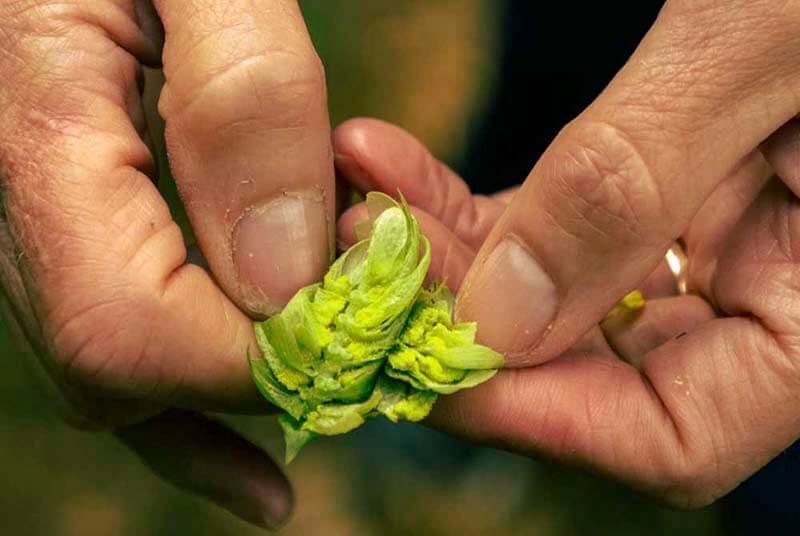
Why do people love hazy beer? Answers will vary, of course. But it’s undeniable that folks across the world enjoy New England-style IPAs because they are uber juicy in both flavor and aroma. Big bursts of citrus, pineapple, grapefruit, mango, and more draw consumers into a hazy’s turbid depths. But what if we told you that you could make their hazies even juicier? Or, more accurately, that you could unlock organic sulfur compounds already existing in your hops and malt that would enhance the aromas of your beer?
That’s the research that Omega Yeast has been undertaking for the last several years, engineering a strain of genetically modified yeast—thiolized yeast—intent on cracking into those organic aromatic compounds called thiols.
So if we told you that you could make your hazies, West Coast IPAs, or other predominantly hop-forward styles pack a stronger aromatic punch, wouldn’t you want to learn about that research?
We spoke directly with Omega Yeast and some brewers in the industry leveraging this new analysis to put together a beginner’s guide to thiols and thiolized yeast.
Just like yeast itself, this is a living, breathing, evolving exploration with new studies and papers coming out constantly. But for now, here’s a first step to help you understand the basics of how to best leverage thiolized yeast to make your most aromatic beer.
(Photo above courtesy of Bell’s Brewery)
Affordable, Industry-Leading Brewery Software
What Are Thiols and How Do Thiols Impact Beer?
Essentially organic sulfur compounds found in various agricultural products including fruit, hops, and even grain, thiols are naturally existing fragrant elements.
“Thiol compounds are really just highly aromatic compounds,” says Laura Burns, director of research and development at Omega Yeast. “Thinking about hops for the brewing industry, hops have a lot of different thiol compounds, but the ones that are more fruit driven are 3SH and 4MSP—passion fruit, grapefruit, black currant, and rhubarb aromas.”
In other words, thiols that exist in hops and malt can help provide added aromas to your beer.
And not just any added aromas. But ones highly sought after in craft beer.
The key with thiols is that they register on the aromatic threshold in parts per trillion concentrations, meaning “they’re extremely potent,” says New Image Brewing Founder Brandon Capps, who lays it out this way: “Thiols are a thousand times more aromatic or have a thousand times lower threshold than something like diacetyl or dissolved oxygen,” which are measured in parts per billion or parts per million, respectively.
Thiols are just another layer of research that is slowly being explored.
Capps, who has dived deep into studies and papers on thiols and thiolized yeast, implementing many techniques into New Image’s own beers, breaks it down like this: “This thing by weight is a trillionth of the product we’re working with, be that hops or malts, but over the last twenty years different labs and studies have peeled back layers: What’s this last .01% of weight by products we’re using and how significant is it?”
Turns out that last little bit is actually pretty significant.
The trick is that while some thiols are already readily available, others are locked away, essentially needing a key in order to be activated.
What Are the Two Different Types of Thiols?

Photography courtesy of Yakima Valley Hops
Thiols exist in nature in two different forms: free thiols and precursor or bound thiols.
Free Thiols
Free thiols are thiol compounds that are already unlocked and create aromas. For instance, many hops that are well known for their fragrance—Citra, Mosaic, Simcoe and Nelson, to name a few—are higher in free thiols.
It’s these readily available aromatic compounds that make hops like Citra and Mosaic fragrant and subsequently so beloved.
“Free thiol aroma is one of the biggest indicators of high-quality hops,” says Burns. Turns out there is actually a specific scientific reason behind some of the most popular hops in modern craft brewing.
But what about other hop varieties? Inside those, Burns says, there are a ton of what are called precursor forms of these thiols, or ones capable of producing aromas, just not in their current state.
And even hops with a higher amount of free thiols aren’t being fully optimized for their aroma potential.
“As we’re peeling back the layers in a hop like Citra, where however many micrograms of thiols are available per kilogram, there’s about one percent of total thiol content of a hop like Citra available as free thiols and about ninety-nine percent available as a bound precursor,” says Capps.
It’s these precursor/bound thiols that Omega Yeast is trying to unlock with thiolized yeast.
Precursor/Bound Thiols
Think of precursor thiols as ones stored inside a safe; they need something to crack into them.
In research dating back decades, the wine industry actually discovered that the distinctive passion fruit aromas in popular grape varieties like sauvignon blanc could be traced to thiol aroma.
So Omega Yeast thought: “How can we get at these precursors in hops?” says Burns, who notes they quickly discovered that thiols exist not only in hops, but also in malt.
“Precursor means a thiol conjugated to a cysteine amino acid or glutathione, and the way these are bound to thiols is a common sulfur bond,” says Burns. “So the precursor in the hops is actually broken down by enzymes that the yeast possess.”
The goal became: How to activate those precursors in certain hop and malt varieties to be transformed into free thiols so brewers could leverage those aromatic compounds while brewing.
In other words, yeast became the key.
What Is Thiolized Yeast?

Photography courtesy of Omega Yeast
The answer specifically: thiolized yeast.
Or yeast strains that have been identified as potentially good companions for unlocking these aroma-enhancing thiols in beer. Omega Yeast genetically modified certain yeast strains to activate these bound/precursor thiols.
“What these labs are doing is using this technology for gene editing to modify the DNA of these yeasts to change the way they interact with the substrate they’re in,” says Capps. “When we say thiolized yeast, what we’re saying is the yeast did not previously have a capability or substantial capability of converting cysteine-amino-acid-bound thiol precursors to free thiols; it now has that ability due to genetic modification where a gene was turned on.”
Essentially, Omega Yeast engineered certain yeast strains to activate an enzyme needed during fermentation to transform these precursors into free thiols.
For example, in Omega Yeast’s most popular thiolized yeast called Cosmic Punch, Burns says they took the parent strain British V and activated the yeast β‑lyase enzyme—ICR7.
“In normal fermentations in wort, yeast won’t express this enzyme,” says Burns. “Basically, there are so many nutrients available for the yeast it doesn’t express this enzyme…because the yeast doesn’t need it; it doesn’t turn on, so in Cosmic Punch we activated it and turned it on during fermentation.”
Consider it similar to flipping a light switch in a dark room (and these Omega Yeast thiolized yeast strains are the finger). “Traditional yeast strains in beer fermentation really struggle to turn on this enzyme at all; it’s not something we normally see in our traditional brewing strains,” says Burns. Meaning that, with a thiolized yeast strain, “now we can express [this enzyme]; it’s active and converting these thiol precursors during fermentation,” says Burns.
Now with thiolized yeast turning on the proverbial light, brewers are able to unlock those bound thiols in the beer, releasing them into free thiols and producing these highly aromatic compounds.
Hence: more aromatic beer.
Of course, the exact aromas vary depending on the raw materials used, but if, for example, you’re using something like Motueka in your recipe, you can expect higher passion fruit, guava, and tropical fruit aromas.
The Three Most Popular Strains of Thiolized Yeast
Although by far Omega Yeast’s most popular thiolized yeast strain, Cosmic Punch isn’t the only variety available.
Cosmic Punch, Helio Gazer, Star Party, and Lunar Crush are all thiolized yeast strains created by Omega Yeast.
And each seems to have its own nuances.

Graphic courtesy of Omega Yeast
Cosmic Punch
Released almost two years ago, Cosmic Punch has been widely used across the industry with much success “because it activates thiols to a level that makes them more apparent but doesn’t become a super thiol bomb,” says Burns. “It’s versatile; People can use a lot in normal hoppy recipes without it being too overwhelming.”
Brewers like Capps, who has had great success brewing with Cosmic Punch. New Images’ Phanny Pack series, now in its fifth iteration, leverages Cosmic Punch to produce a super fragrant, perfectly balanced hazy IPA with Southern Cross, Citra, Idaho Gem, and Phantasm.
“Currently Phanny Pack is, in my opinion, the best beer we’re making with Cosmic Punch,” says Capps.
Helio Gazer
On the other hand, Helio Gazer approaches unlocking precursor thiols a bit differently, consequently producing different results.
Instead of activating the yeast β‑lyase enzyme ICR7, this thiolized yeast strain has been engineered to use a bacterial β‑lyase enzyme more commonly referred to as cysteine thiolized because it’s very specific at releasing thiols from cysteine.
It’s essentially kind of like a thiolized yeast on steroids, creating thiols in the 5,000 parts per trillion range (instead of the 500 parts per trillion with Cosmic Punch).
According to Burns, Cosmic Punch produces twenty times the amount of thiols you’d need for it to be recognized by the sensory threshold, while Helio Gazer produces 200 times the amount.
“New versions we have that express this bacterial cysteine thiolase have aromas coming through like sauvignon blanc wine that are very tropical…but on its own, it’s very intense and sometimes, depending on who tastes it, some people like it and some people do not love it,” says Burns. “It’s a polarizing compound.”
If Cosmic Punch were a first date, Helio Gazer might be a third—it’s just a little stronger and packs a bit more of a punch.
Capps says for him the jury is still out on Helio Gazer. He recently brewed a collab at Offset Bier Co. using Helio Gazer that he found “very potent and currently very sulfury.”
But he also has a personal beer at New Image in the tanks with Helio Gazer that he has yet to taste but he says his “team is raving about.”
Again, there are so many variables here that could be contributing to the final beer, but in general, Helio Gazer is a more potent thiolized yeast that needs to be handled with a bit more care.
Star Party
Similarly, Star Party is a newer thiolized yeast strain. Omega Yeast modified Star Party from its parent Chico strain, so Burns recommends using it in a West Coast IPA.
But ultimately, Burns says with more powerful thiolized yeast strains such as Helio Gazer and Star Party a bit more nuance and balance is needed. “They’re very potent, so it’s about working them into a recipe and balancing out the thiol expression with hop aroma and hop intensity.”
She and Capps have a few recommendations.
Three Tips for Brewing With Thiolized Yeast

Photography courtesy of Omega Yeast
With thiolized yeast there are so many different levers you can pull, so Burns and Capps have a few key pieces of advice.
Test, Test, and Test Again
The best advice Burns can give brewers interested in utilizing thiolized yeast is to experiment with smaller batches.
“One of the things I think is really helpful is if you’re running your typical IPA recipe on the brewhouse, just pull off some wort before you pitch your yeast, get a small pitch of one of these new strains, and try it out,” says Burns. “Just mimic your recipe with your house yeast and one of the new thiolized yeasts to see how it changes the beer.”
Overall, even as Omega Yeast’s research has developed, they’ve discovered that different raw materials bring different thiols into the equation. Some could be hop derived—creating sharper grapefruit or even dank aromas depending on the hop.
But others could be malt derived—adding more passion fruit aromas.
“When you’re looking at these new strains, just realize there is quite a bit of variability in recipe design that will impact how these beers come out,” says Burns. “Try pulling off some wort from your main beers and doing a little test trial ferment to see how you like it.”
Capps agrees that actually testing different recipes and working with different variables is key here.
He’s been trying to get a little less in the weeds on all the research data and technical advice and a little more back to playing around with different recipes. “I listen to my mouth because ultimately what matters is how the beer tastes,” says Capps. “I can talk a mean science game all day long, but if the beer tastes like tropical toilet water it doesn’t matter.”
Since there are so many facets to understand and play with here, Capps started four different series of beers at New Image dedicated to just one component of research around thiols and thiolized yeast.
Three of those series move the needle faster by incorporating bigger changes.
But one series called Phanny Pack culminates all of Capps’ trials into one now-flagship, year-round series utilizing Cosmic Punch.
With Phanny Pack, “this is a beer that we are brewing with the least batch-to-batch changes in order to really understand the impact of each change,” says Capps, who notes they brewed five different versions before actually settling on what they’re calling the Core. “We modify the Core based on what we’re learning from the other series…but we move more slowly and gradually with Phanny Pack to dial in those changes.”
Meaning what New Image produces is a beer that is, to the best of its ability, optimizing thiols and thiolized yeast based on what Capps has read, studied, and implemented in his own beers.
Because at the end of the day, it’s “ultimately, how does the beer taste?” says Capps. “We’re not producing thiols, we’re producing beer that tastes good… That’s the grain of salt that everyone should have in the back of their mind. You don’t want to make a faster plane if the plane is just crashing.”
In Capps’ opinion, Phanny Pack is currently the best beer New Image is making with the thiolized yeast strain Cosmic Punch. “We’re putting all the best practices into that beer at any given time and brewing it consistently,” says Capps “We’re growing in our own knowledge of using thiolized yeast and thiol precursor products to produce the best IPA we know how.”

Photography courtesy of @nibrewing | New Image Brewing
Consider Changing Out Your Grist to Include Wheat and Oats or Blending Yeasts
Knowing that different thiols come from different raw materials can be helpful when altering a recipe that uses thiolized yeast.
If you’re looking to dial back the intensity of the thiols, you can actually include more wheat and oats in your grist.
Research has shown that wheat and oats do not contain a high amount of these free or precursor thiols.
So for example, “if you want to add nuance with the Helio Gazer, you can balance it out by changing your grist because all of that thiol precursors are coming from the barley malt not wheat and oats,” says Burns.
You can also consider blending thiolized yeast with a house strain at a ratio that gives you the right amount of thiol output.
Again, it all goes back to trial and error, pulling certain levers to find what works best.
Try Mash Hopping
On the other hand, if you’re looking to maximize your thiol conversion and aroma output, consider mash hopping.
An idea of front loading your mash with hops, mash hopping essentially provides your wort with more of the hop thiol precursors for the thiolized yeast to convert during fermentation into thiol aroma.
Essentially with mash hopping, you’d want to add hops reported to be very high in thiol precursors—Cascade, Saaz, Calypso, and Motueka, for example—to the mash. “These are all hops that have three times the level of precursors as some other varieties,” says Burns. “We have really solid data to show that…we’re seeing a twenty to fifty percent increase in thiols in fermentation with mash hopping.”
Burns recommends that mash hopping really works best when using a thiolized yeast such as Cosmic Punch “that is pretty versatile when you’re trying to get the most thiols into fermentation,“ she says, cautioning that “it’s probably not as necessary with the newer strains because they’re already so potent that you don’t need to pull that lever.”
Consider the Law of Diminishing Returns here. Strains like Helio Gazer and Star Party can unlock thiols in the 5,000 parts per trillion. So when you’re talking about a twenty to fifty percent increase in thiols, you’re already so far above the sensory threshold there that mash hopping isn’t worth the squeeze (you don’t just want to waste hops in the mash if you don’t need to).
With Cosmic Punch, on the other hand, that registers thiol production around 500 parts per trillion, according to Burns, mash hopping gives a bigger bump that has a more significant impact.
What Beer Styles Work Best With Thiolized Yeast?

Photography courtesy of @nibrewing | New Image Brewing
If you’ve come to learn anything about thiols and thiolized yeast, it’s that there will always be variability.
The answer here isn’t straight, but rather more like a curved line, one we can’t quite see around the bend yet. That’s because there is still so much to explore.
But for now, Burns does have a few suggestions: “The big applications of these are going to be complementary to anything that’s really hoppy,” she says. “The best styles to try in each of them would fit a different hoppy style.”
For example, Burns suggests using Cosmic Punch and Helio Gazer with New England-style hazy IPAs.
Whereas Star Party, on the other hand, goes hand in hand with West Coast IPAs.
If you’re looking for even more variation, a recent strain called Lunar Crush would be fun for newer styles such as IPL, Cold IPA, and lager.
But again, Burns emphasizes these are “just ideas, jumping-off points on where you should try them out.”
As brewers, the exploration is really up to you. Go forth, test out these thiolized yeast strains, pull different levers, and see how you can successfully unlock the most aroma in your recipes to brew the best beer possible.



